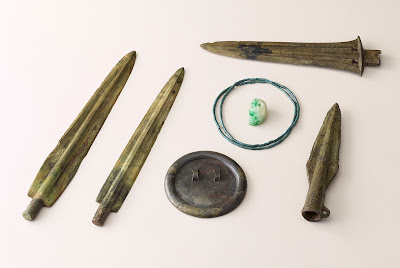Feature Exhibition Room 4
April 19th (Tue.) ~ June 12th (Sun.), 2022
Grave goods excavated from the
Yoshitake-Takgagi site
One of the things that characterizes the Yayoi period (c.800 BCE – 250 CE) is the bronzeware. Fukuoka boasts one of the largest quantities of bronzeware excavated in Japan.
Bronzeware was introduced to the Japanese
archipelago, initially in very small quantities, not too long after the
introduction of rice cultivation.
Then, in the second and third centuries
BCE, it was fully introduced to the Japanese archipelago.
Much of the bronze introduced to Japan was
used for making weapons, such as bronze spearheads, daggers, and halberds.
First, these were made in the Korean peninsula, but it soon became possible to
manufacture these artifacts in Japan.
After the first century BCE, the amount of
bronzeware brought from China, such as mirrors and coins, began to increase.
Various kind of bronzeware was also produced in Japan including Tomoe-shaped
bronzeware, which were unique to Japan.
This exhibition brings together a
collection of bronzeware produced during the Yayoi period and excavated in
Fukuoka. As well as the fascinating bronze items currently on display in the
Feature Exhibition Room, we hope you will take the time to enjoy the exhibits
on display in the Permanent Exhibition Room.
 |
| Exhibition view |







